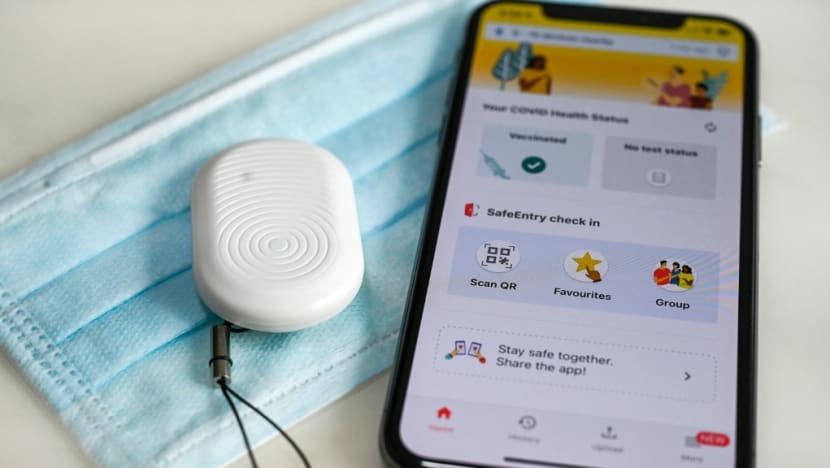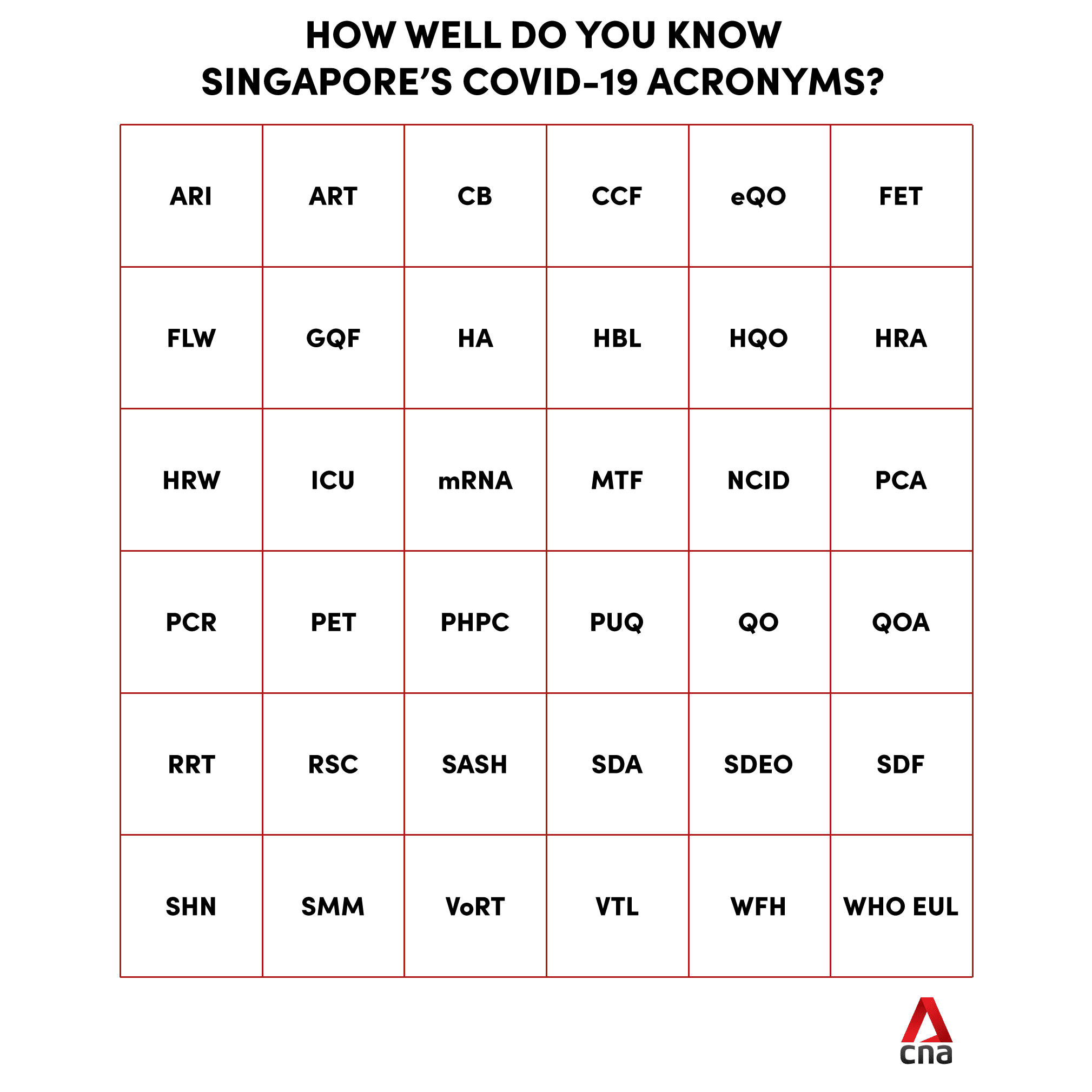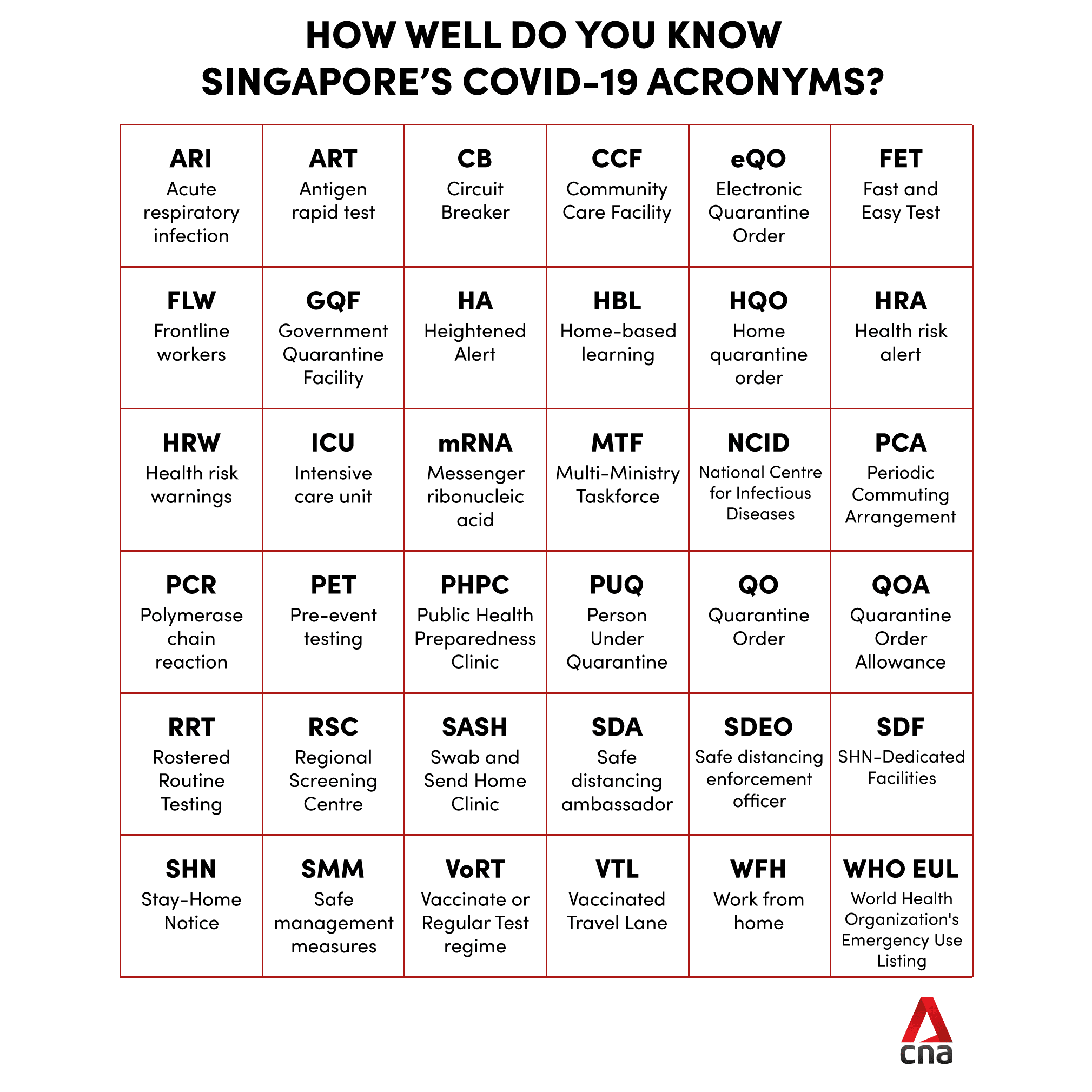A handy guide to Singapore's COVID-19-related acronyms

A surgical mask beside a token and mobile phone application, both using the TraceTogether digital system to aid contact tracing efforts, on Sep 1, 2021. (File photo: AFP/Roslan Rahman)
SINGAPORE: Since the battle against COVID-19 began in early 2020, an abundance of acronyms has entered common parlance in Singapore.
From PCR (polymerase chain reaction) to PUQ (person under quarantine) and PHPC (public health preparedness clinic), the list continues to grow.
If you find yourself muddled in an alphabet soup, here’s a guide on what the acronyms mean:
- AA: Approved absence. As a precautionary measure, students and staff will be placed on approved absence in certain scenarios. This includes if they or their household members have to undergo mandatory COVID-19 testing due to a cluster, or if their household members have flu-like symptoms.
- ARI: Acute respiratory infection. Symptoms of ARIs are similar to those of COVID-19 – such as fever, cough, runny nose, sore throat, loss of taste or smell.
- ART: Antigen rapid test. A type of COVID-19 test you can do on your own. They work by detecting viral proteins in nasal swab samples, and are faster and less intrusive than PCR tests. See “PCR” for more.
- CB: Circuit breaker. A nationwide partial lockdown implemented from Apr 21 to Jun 1, 2020, to put the brakes on escalating COVID-19 infections.
- CCF: Community care facility. These cater to COVID-19-positive people who are clinically well, have mild symptoms and do not require much medical care. Examples of CCFs include Connect @ Changi at the Singapore Expo and D'Resort NTUC.
- Stepped Up CCFs, introduced in September 2021, cater to elderly patients who are stable, mildly symptomatic, clinically well but with some underlying conditions that could make them more susceptible to a potential worsening of illness.
- DORSCON: Disease Outbreak Response System Condition. A colour-coded framework that shows the current disease situation, providing general guidelines on how to prevent and reduce the impact of infections. Singapore has been at Orange, the second-highest level, since February 2020.
- eQO: Electronic quarantine order. The version of a quarantine order that one receives via SMS. See “QO” for more.
- FET: Fast and Easy Test. Refers to antigen rapid tests. The phrase is used in conjunction with rostered routine testing – see “RRT” for more.
- FLW: Frontline workers. These are workers in roles and industries that are of critical importance to the functioning of Singapore. Examples include healthcare workers, transport workers, hawkers, cleaners, teachers and supermarket staff.
- GQF: Government quarantine facility. These house individuals who need to be isolated as they have come into close contact with COVID-19 cases. Examples include some chalets at Changi and Loyang.
- HA: Heightened Alert. The phrase has been used to differentiate between initial planned phases of reopening and subsequent stages that have more precautionary measures in place, such as Phase 2 vs Phase 2 (HA).
- HBL: Home-based learning. When lessons and materials are made accessible online, allowing students to attend school from home.
- HQO: Home quarantine order. Those under an HQO have to isolate at home.
- HRA: Health risk alert. These are issued to people who have possibly been exposed to COVID-19. They should monitor their health, conduct self-testing and seek medical attention if they are unwell.
- HRW: Health risk warning. These are issued to those identified as close contacts of COVID-19 cases, based on TraceTogether and SafeEntry data. Those who receive HRWs must comply with testing and isolation requirements by law.
- ICU: Intensive care unit. The department in hospitals that house those who are critically ill.
- LOA: Leave of absence. Students and school staff are placed on LOA in several situations, such as when they have been in close contact with confirmed cases, but are not placed on a quarantine order; if household members are serving a quarantine order or a stay-home notice at the same residence.
- mRNA: Messenger ribonucleic acid. The technology behind certain COVID-19 vaccines, including the Pfizer-BioNTech and Moderna vaccines. These types of vaccines teach cells how to make a protein that triggers an immune response. The immune response produces antibodies to protect the vaccinated person.
- MTF: COVID-19 multi-ministry task force. The MTF is meant to coordinate a whole-of-government response to the pandemic. Its co-chairs are Health Minister Ong Ye Kung, Trade and Industry Minister Gan Kim Yong and Finance Minister Lawrence Wong.
- NCID: National Centre for Infectious Diseases. A national public health institute designed to strengthen Singapore’s capabilities in infectious disease management and prevention.
- PCA: Periodic Commuting Arrangement. A travel lane agreement between Singapore and Malaysia to facilitate the movement of workers between both countries.
- PCR: Polymerase chain reaction. A type of COVID-19 test that amplifies genetic material so any trace of COVID-19 can be detected. They are more accurate than antigen rapid tests but take longer to produce results.
- PET: Pre-event test. A COVID-19 test taken by individuals who want to enter certain venues or participate in certain events or activities. These include cinemas, congregational services, live performances, conferences and weddings. Some individuals, such as those who are fully vaccinated, may be exempted.
- PHPC: Public Health Preparedness Clinic. These provide subsidised treatment and medication during public health outbreaks. PHPCs were previously activated to deal with haze and the 2009 H1N1 influenza pandemic.
- PUQ: Person under quarantine. An individual who has been served a quarantine order.
- QO: Quarantine order. A legal order requiring suspected COVID-19 cases, or close contacts of confirmed cases, to be quarantined at a designated place.
- QOA: Quarantine order allowance. The QOA scheme allows self-employed people and Singapore-registered companies that have employees under a quarantine order to claim S$100 a day. Approved caregivers of a person under quarantine can also apply for the allowance.
- RRT: Rostered routine testing. Under this surveillance testing programme, certain groups that work in higher-risk settings or live in high-density environments are tested routinely, such as every 14 days.
- RSC: Regional screening centre. These centres carry out COVID-19 swab tests for "target groups from the general community" or those who have been diagnosed with acute respiratory infection, said the Health Ministry.
- SASH: Swab and Send Home Clinic. These are PHPCs that can perform swab tests for patients. Your doctor will assess and swab or refer you to a facility, such as a regional screening centre, for a swab test if needed.
- SDA: Safe-distancing ambassador. An ambassador’s task is to remind businesses and people of safe-distancing measures, such as wearing a mask and leaving sufficient space when queuing.
- SDEO: Safe-distancing enforcement officer. These officers have the power to take enforcement action against people for flouting rules, such as issuing fines.
- SDF: SHN-dedicated facilities. These refer to accommodation for incoming travellers who are issued stay-home notices. See “SHN” for more.
- SHN: Stay-home notice. A legal notice issued under the Infectious Diseases Act that requires travellers to remain in their place of residence or SHN-dedicated facility for a stipulated period. Failure to comply can amount to an imprisonment term and/or fine.
- SMM: Safe management measures. Regulations in place to minimise the risks of COVID-19 transmission. Examples include safe distancing and caps on group sizes.
- TT: TraceTogether. A mobile phone application and/or physical token used for contact tracing efforts.
- TToSE: TraceTogether-only SafeEntry. Refers to a location where SafeEntry – a check-in gateway – has been implemented, and all individuals need to use their TT app or token to check-in.
- VoRT: Vaccinate or Regular Test regime. Under this regime, certain groups of frontline workers will need to be vaccinated against COVID-19, or undergo more regular testing.
- VTL: Vaccinated Travel Lane. Under this arrangement, fully vaccinated people can travel for leisure without serving a stay-home notice in Singapore upon returning. They will have to take up to four PCR tests.
- WFH: Work from home. This is when an employee works from their place of residence, instead of the office.
- WHO EUL: World Health Organization's Emergency Use Listing. A procedure by the WHO that assesses the suitability of novel health products during public health emergencies. Approved vaccines under this include Pfizer-BioNTech, Moderna, AstraZeneca, Johnson & Johnson, Sinopharm and Sinovac.


BOOKMARK THIS: Our comprehensive coverage of the COVID-19 pandemic and its developments
Download our app or subscribe to our Telegram channel for the latest updates on the coronavirus pandemic: https://cna.asia/telegram












